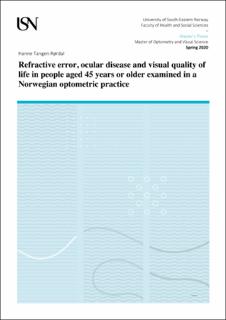Refractive error, ocular disease and visual quality of life in people aged 45 years or older examined in a Norwegian optometric practice
Master thesis
Permanent lenke
https://hdl.handle.net/11250/2671116Utgivelsesdato
2020Metadata
Vis full innførselSamlinger
Sammendrag
The aim of this study is to explore visual function, refractive errors, cataract, age related macular degeneration (AMD), glaucoma, diabetic retinopathy and their association with visual quality of life
(VQoL) among adults 45 years or older, in a Norwegian optometric practice. In doing so, we invited all customers who were 45 years or older, who booked an appointment at Specsavers Haugesund to participate in the study. From January to November 2019, 336 volunteered to participate in the study. All participants underwent a standard visual examination the according to clinical guidelines of The Norwegian association of Optometry and answered the National Eye Institute
Visual Function Questionnaire 25 item (NEI VFQ-25) questionnaire. Data from 293 participants was eligible for analysis, 197 (58.6%) females and 139 (41.4%) males. Participants were divided in two age groups: younger adults consisting of participants aged 45-65 years and older adults aged 66 years and older. The results showed a significant improvement in visual acuity (VA), two lines or more, among 14.3% of the participants. Overall, the participants had good visual function, however, a large group of participants had reduced best corrected visual acuity (BCVA). Reduced vision (0.5 ≤ BCVA < 0.8) was found for 19.7% of participants and 3.8 % were visual impaired (VA < 0.5) with best correction. The mean (SD) spherical equivalent refractive error (SER) was +0.25D ( }1.74), there was no statistically significant difference between the age groups. There were clinical findings of significant cataract among 19.1%, 17.9% of the participants with diabetes had diabetic retinopathy, 5.5% had suspect AMD and 3.75% had suspected glaucoma. Previously unknown ocular disease was disclosed in 24.9% of the participants. The overall mean score for the NEI-VFQ 25 questionnaire for all participants was 87 ( }9). Participants with suspected AMD had a significantly poorer score in the
NEI VFQ- 25 subcategory distance activities compared to people without ocular disease. The study also found a significantly better score for the sub scores distance activities and peripheral vision in our glaucoma suspect participants compared to the healthy group. Older age was statistically significantly associated with lower score for general health and driving. There was no difference in VQoL in participants with reduced vision, cataracts and diabetic retinopathy compared to the group without ocular disease. To conclude, this study found that 1 of 7 improved their VA with two lines or more with refraction and in 1 of 4 cases there was a disclosure of previously unknown eye disease. In this study, we did not find that reduced vision was associated with VQoL, however higher age, AMD and glaucoma influenced the VQoL score. Therefore, optometrists have an important role in the healthcare system as visual examinations reveals uncorrected refractive errors and can prevent unnecessarily reduced vision because of ocular disease.
